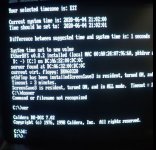My answer seems to have to be checked by an admin before it appears, perhaps I'm still too new to the forum...
I will try to answer again (possibly this third answer will all come at the same time, but I cannot see the posts I tried to make).
Yes, I did MKFS.
I did fiddle around with read/write rights without success. Now, I'm out of ideas. Could it be that freedos, even listed as one of the working DOSes, does not work sometimes? Which other DOS version should I try?
I'm kind of out of empty 1.2M disks, and it is not that easy to try out new DOS versions, as I have no other computer with an 1.2 drive, so I'd rater be pointed in some direction what gives best success rate, if even this may be part of the problem or if it is completely on the server side. When I finally get the 5170 up and running, I will save some of the disks onto a modern computer and be able to exchange data more easily with this old system...
I will try to answer again (possibly this third answer will all come at the same time, but I cannot see the posts I tried to make).
Yes, I did MKFS.
I did fiddle around with read/write rights without success. Now, I'm out of ideas. Could it be that freedos, even listed as one of the working DOSes, does not work sometimes? Which other DOS version should I try?
I'm kind of out of empty 1.2M disks, and it is not that easy to try out new DOS versions, as I have no other computer with an 1.2 drive, so I'd rater be pointed in some direction what gives best success rate, if even this may be part of the problem or if it is completely on the server side. When I finally get the 5170 up and running, I will save some of the disks onto a modern computer and be able to exchange data more easily with this old system...

